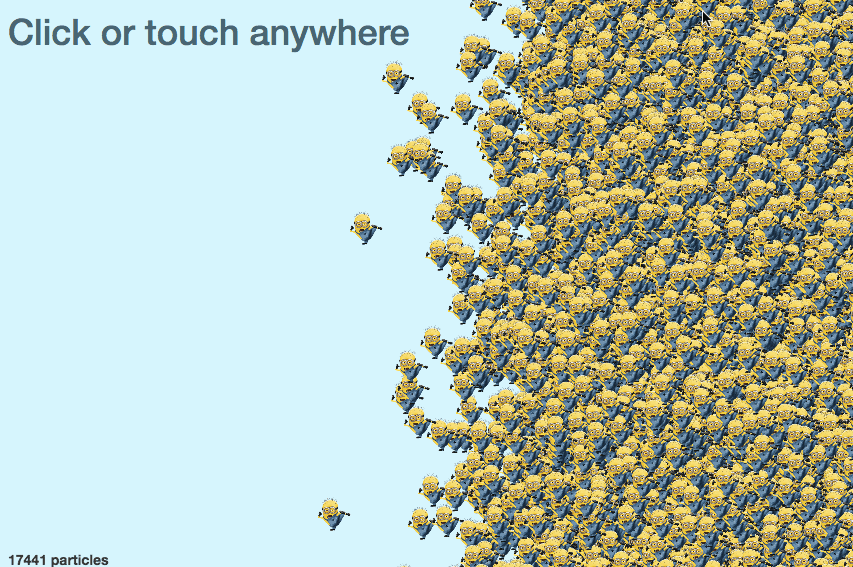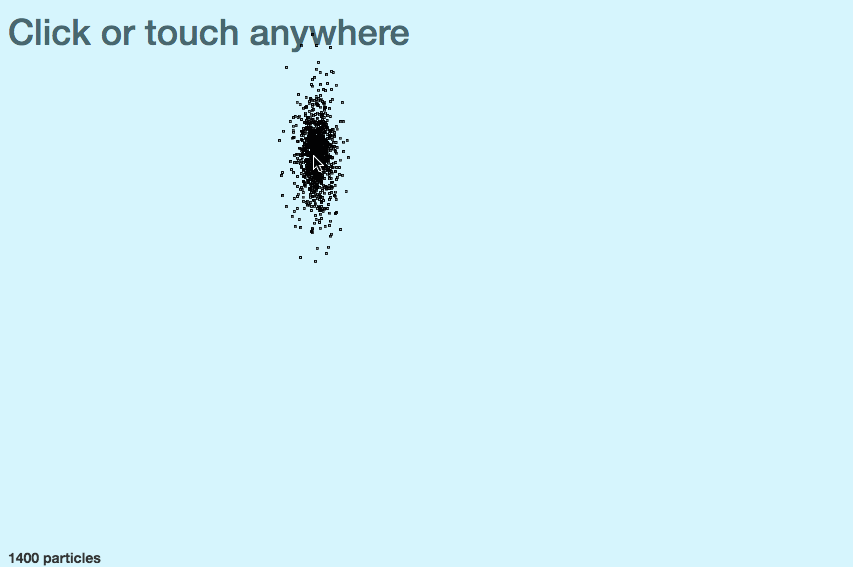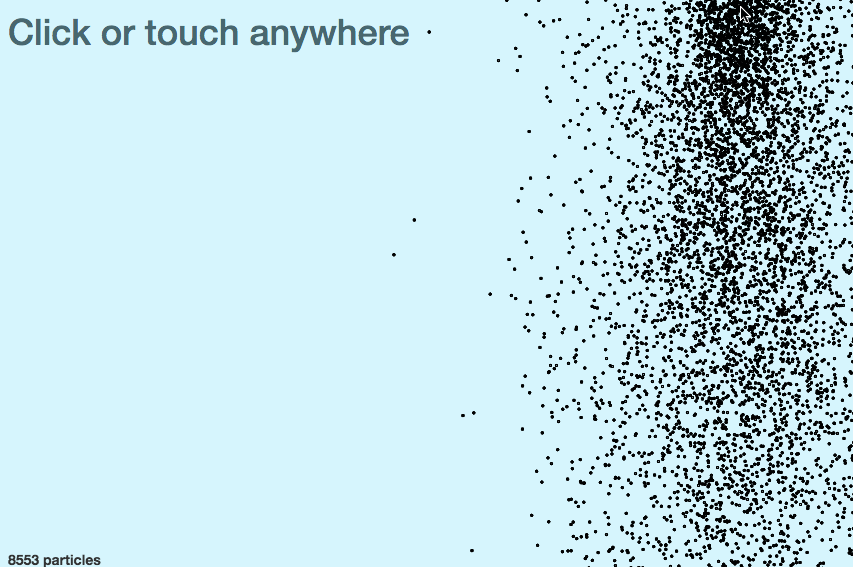This is a Livecoding Recap – an almost-weekly post about interesting things discovered while livecoding. Shorter than 500 words. With pictures. You can follow my channel, here. New content almost every Sunday at 2pm PDT. There’s live chat ?
This week, I had the charisma of a peeled potato. The livestream started with 6 people in the chat, and it ended with 2. Usually it ends with … more.
So sad.
BUT! We learned stuff about canvas.drawImage, and I poked around after the stream and made this glorious bastard. 14,000 smoothly animated particles! \o/

Cool, huh? Such a shame it didn’t work during the stream. Then 3 people would’ve stayed!
The first thing we tried was the concept of sprites. Instead of doing .arc and .stroke for every particle, you do it once, then copy-pasta that particle to other places like this:
// draw a sprite particle in componentDidMount
this.context.beginPath();
this.context.arc(1.5, 1.5, 1, 0, 2*Math.PI, false);
this.context.stroke();
// copy pasta particle
drawParticle(particle) {
let { x, y } = particle;
this.context.drawImage(this.canvas, 0, 0, 3, 3, x, y, 3, 3);
}
Using .drawImage like this tells canvas to take pixels from the top left corner and copy them to a new place. A fast operation in theory, but something went wrong for us.

Terrible. Even worse than before. Copying those few pixels thousands of times grinds our animation to a halt. With a few thousand elements, each frame render takes a few seconds.
But at least the .drawImage. approach makes it easy to render arbitrary images instead of particles. Instead of using this.canvas as the source, you can use an arbitrary Image() object, which you can fill with an image from any URL on the internet.

Strange … that feels smoother, doesn’t it? I’m not going crazy, right?
Anyway, there’s only one thing left to do: decouple physics from frame rate. A big part of why the animation feels so slow is that we only calculate new particle positions once per frame, which makes sense because we’re only drawing them once per frame.
Our frame rate is not up to snuff for that. We’re dropping frames, so we have to compensate for that in our calculation. The idea is that for each drawn frame, we have to pretend like multiple physics frames happened.
Fixing physics happens in the reducer and looks like this:
// reducer
case ‘TIME_TICK’:
let {svgWidth, svgHeight, lastFrameTime} = state,
newFrameTime = new Date(),
multiplier = (newFrameTime-lastFrameTime)/(1000/60); // N frames dropped
let movedParticles = state.particles
.filter((p) => {
return !(p.y > svgHeight || p.x < 0 || p.x > svgWidth);
})
.map((p) => {
let [vx, vy] = p.vector;
p.x += vx*multiplier;
p.y += vy*multiplier;
p.vector[1] += Gravity*multiplier;
return p;
});
return Object.assign({}, state, {
particles: movedParticles,
lastFrameTime: new Date()
});
We start by tracking timestamps for each frame and calculating a multiplier. Then, we multiply every position and vector change with the multiplier and voilà: time-based (instead of frame-based) physics.

So smooth! I had to increase the number of particles generated on every animation tick up to 2000 just to see anything interesting going on. Insane.
Mission accomplished, right? It’s smooth up to 8,000 particles, and we can’t push it to put more than that on-screen. But the minions wouldn’t stop niggling at me.
I wonder what happens if we put the minion sprite and the better physics together.

Ho boy! 14,000 smoothly animated minions! \o/
With a production build and a big screen, you can reach over 20,000 minions on screen, and it still looks smooth. Try it.
I have no idea why it’s faster to drawImage a complex .png than a circle. Or why it’s faster to drawImage an Image() object than a part of the canvas. It makes no sense, but here we are.
Do you know?
PS: the edited and improved versions of these videos are becoming a video course. Readers of the engineer package of React+d3js ES6 get the video course for free when it’s ready.
Continue reading about Livecoding #16: canvas.drawImage performance is weird but magical
Semantically similar articles hand-picked by GPT-4
- Livecoding #15: Reaching the limits of canvas redraw speed
- Livecoding #14: Mostly-smooth animation up to 4,000 elements with React and canvas
- Livecoding #13: rendering React components with canvas
- Livecoding #12: towards animating 10k+ elements with React
- Livecoding #17: Particle physics is hard
Learned something new?
Read more Software Engineering Lessons from Production
I write articles with real insight into the career and skills of a modern software engineer. "Raw and honest from the heart!" as one reader described them. Fueled by lessons learned over 20 years of building production code for side-projects, small businesses, and hyper growth startups. Both successful and not.
Subscribe below 👇
Software Engineering Lessons from Production
Join Swizec's Newsletter and get insightful emails 💌 on mindsets, tactics, and technical skills for your career. Real lessons from building production software. No bullshit.
"Man, love your simple writing! Yours is the only newsletter I open and only blog that I give a fuck to read & scroll till the end. And wow always take away lessons with me. Inspiring! And very relatable. 👌"
Have a burning question that you think I can answer? Hit me up on twitter and I'll do my best.
Who am I and who do I help? I'm Swizec Teller and I turn coders into engineers with "Raw and honest from the heart!" writing. No bullshit. Real insights into the career and skills of a modern software engineer.
Want to become a true senior engineer? Take ownership, have autonomy, and be a force multiplier on your team. The Senior Engineer Mindset ebook can help 👉 swizec.com/senior-mindset. These are the shifts in mindset that unlocked my career.
Curious about Serverless and the modern backend? Check out Serverless Handbook, for frontend engineers 👉 ServerlessHandbook.dev
Want to Stop copy pasting D3 examples and create data visualizations of your own? Learn how to build scalable dataviz React components your whole team can understand with React for Data Visualization
Want to get my best emails on JavaScript, React, Serverless, Fullstack Web, or Indie Hacking? Check out swizec.com/collections
Did someone amazing share this letter with you? Wonderful! You can sign up for my weekly letters for software engineers on their path to greatness, here: swizec.com/blog
Want to brush up on your modern JavaScript syntax? Check out my interactive cheatsheet: es6cheatsheet.com
By the way, just in case no one has told you it yet today: I love and appreciate you for who you are ❤️
